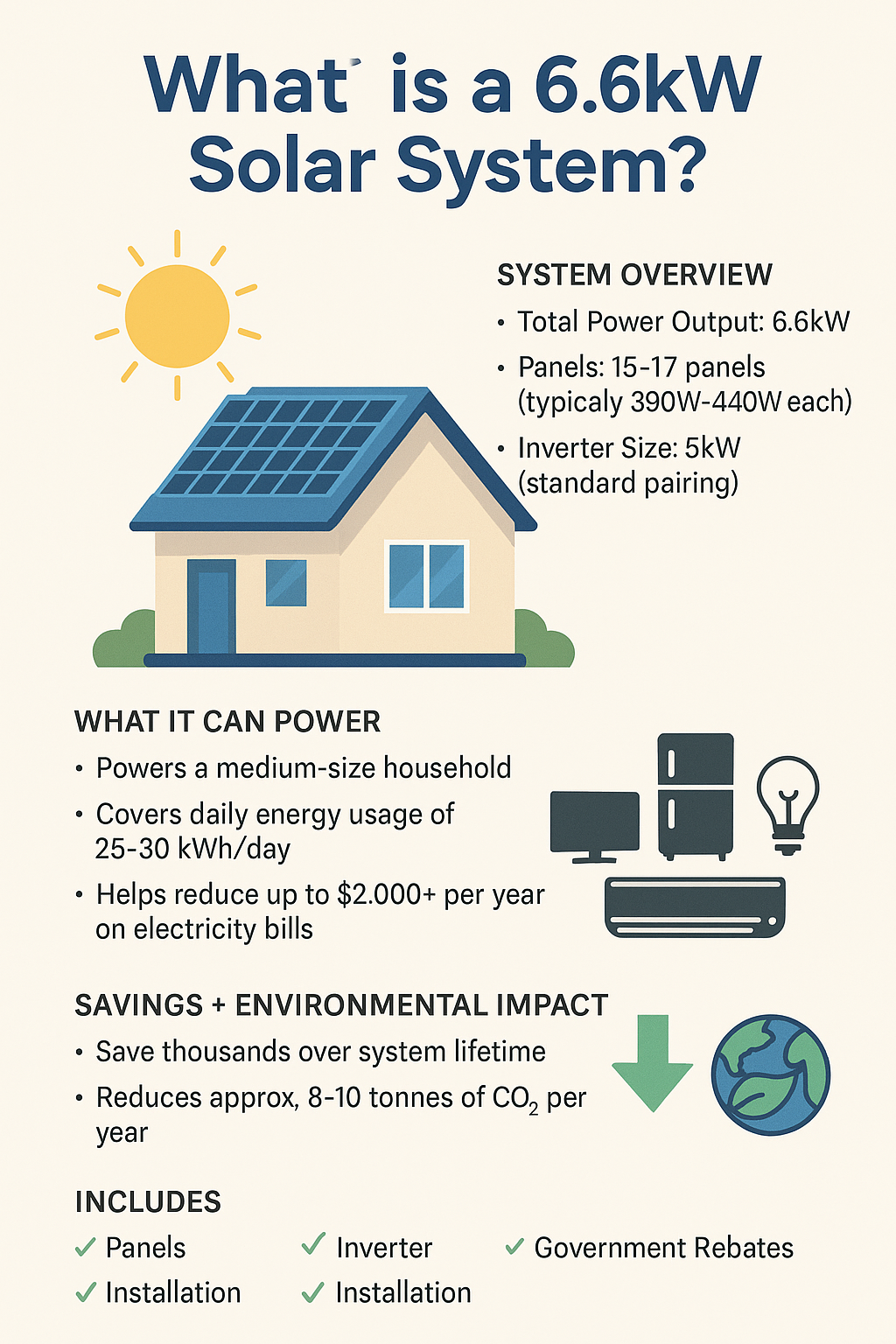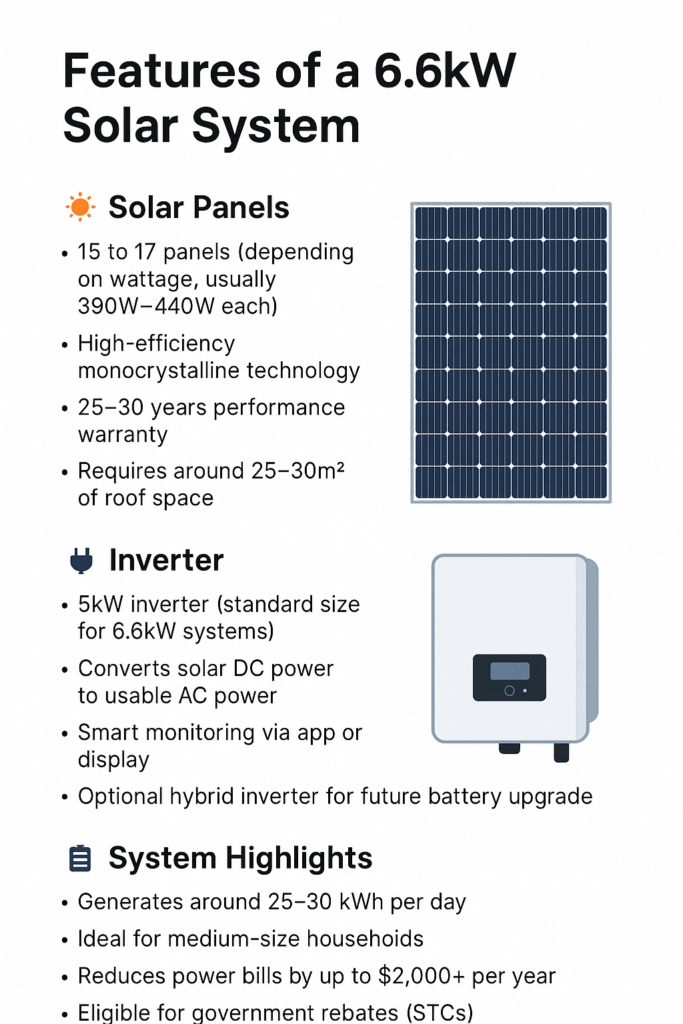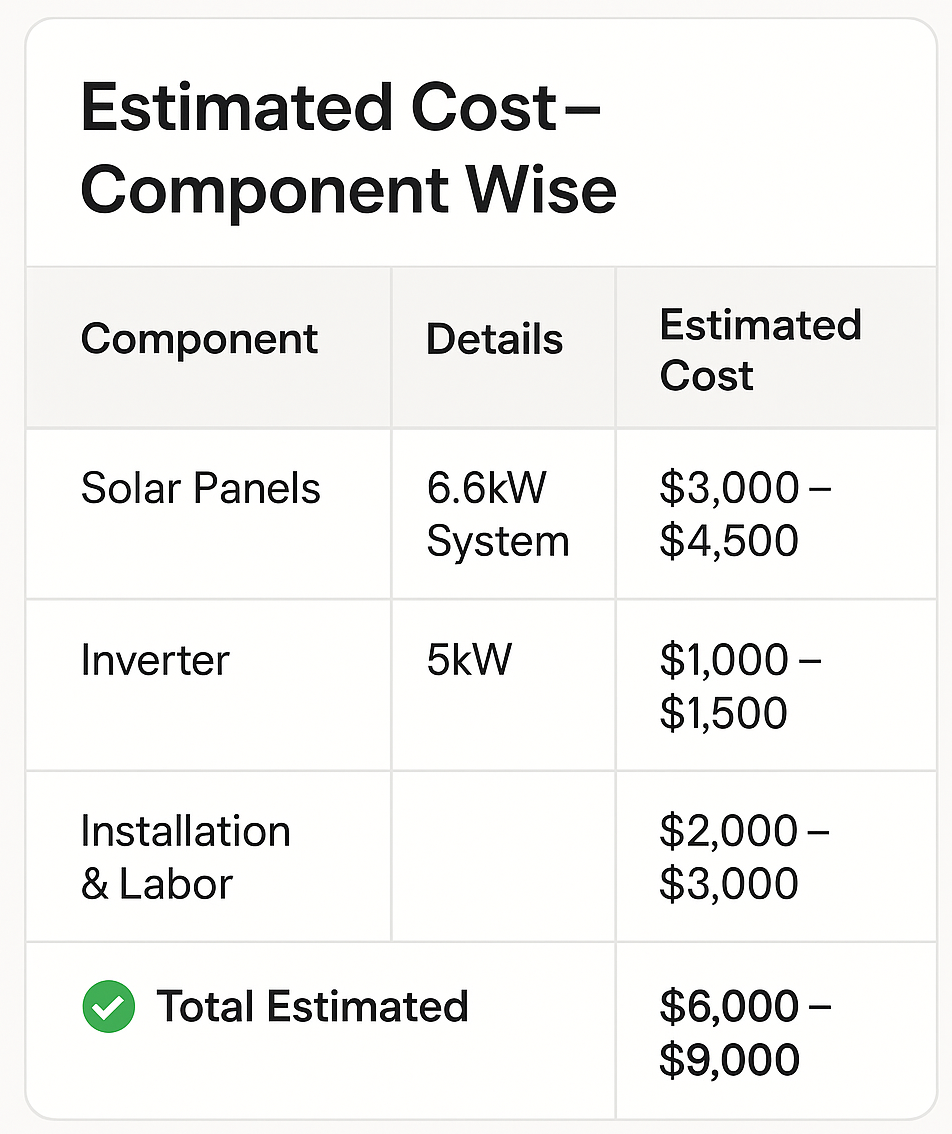
What Is a 6.6KW Solar System?
A 6.6kW solar system refers to the total capacity of solar panels installed on a rooftop or other space for harnessing solar energy. This power rating, measured in kilowatts (kW), indicates the system’s maximum energy output under ideal conditions. For most medium households, a 6.6kW system offers a sufficient balance between energy production and cost-efficiency, making it a popular choice.
Unlike smaller systems, which may not meet the full energy demands of a household, a 6.6kW solar system provides a more reliable energy source, allowing homeowners to reduce their reliance on grid electricity and save on energy bills. This system is capable of powering a variety of household appliances, including air conditioners, lighting, and other essential devices.
With the advancements in solar panel efficiency, this system size is becoming increasingly viable for medium-sized homes, offering long-term financial and environmental benefits.


Features of a 6.6kW Solar System
A 6.6kW solar system offers a variety of features designed to maximize efficiency and minimize energy costs for homeowners. Below are the key characteristics:
- Average Daily Output: On average, a 6.6kW solar system generates between 24-30 kWh per day, depending on location, weather conditions, and panel orientation.
- Compatibility with Inverters: This system often pairs well with a 5kW inverter, providing efficient power conversion from DC to AC.
- High-Efficiency Panels: Modern solar panels, such as monocrystalline panels, boost the output of 6.6kW systems by maximizing sunlight absorption.
- Energy Savings: By producing its own energy, a 6.6kW solar system can significantly lower monthly electricity costs and provide long-term savings.
- Durability: These systems are built to last, with most solar panels offering a lifespan of 25 years or more, backed by warranties.
These features of a 6.6kW solar system make it a cost-effective solution for households looking to reduce their carbon footprint and electricity expenses.
Number of Panels in a 6.6kW Solar System
The number of panels in a 6.6kW solar system varies depending on the wattage of each panel. Solar panels typically come in 300W to 400W options. Let’s break down the calculation:
- 300W Panels: A 300W panel would require approximately 22 panels to make up the 6.6kW system.
- 400W Panels: If you opt for more powerful panels, around 16-17 panels would be needed for the same output.
The number of panels in a 6.6kW system can affect the space required for installation and the overall cost, so it’s important to consider your roof’s available area and the desired energy efficiency when selecting panel wattage.

Average Price and Installation Cost of a 6.6kW Solar System
The average price of a 6.6kW solar system varies depending on the brand, the quality of the panels, and location. Here’s a breakdown of the typical costs as Shown in the Table
Other factors that influence the installation cost of a 6.6kW system include:
- Regional Pricing Variations: The cost of solar systems can vary based on your location due to differences in labor rates, materials, and utility prices.
- Government Incentives: Many regions offer rebates or tax credits to reduce upfront costs, which can significantly lower the installation cost of a 6.6kW solar system.
- Panel Efficiency and Brand: Higher-quality panels with better efficiency ratings may come at a higher price but offer better performance and energy output.
Despite the initial investment, the average price of a 6.6kW solar system offers substantial savings in the long term through lower energy bills.
Output of a 6.6kW Solar System
The output of a 6.6kW system is an essential factor in determining how much energy it can generate. Typically, the system produces:
- 24-30 kWh per day, depending on sunlight exposure.
- 8,760-10,950 kWh annually, which can meet most of the energy demands for medium households.
Several factors can influence this output, including:
- Geographical Location: Solar energy production is higher in sunnier regions.
- Panel Orientation and Tilt: Proper installation can help optimize the output of a 6.6kW system.
- Shading and Weather: Cloudy days or shading from nearby trees can reduce efficiency.
- Maintenance: Regular cleaning and upkeep ensure optimal performance.
By generating a significant portion of a household’s energy needs, a 6.6kW solar system can help you save on electricity bills and contribute to a greener environment.
Benefits of a 6.6kW Solar System
The benefits of a 6.6kW solar system are numerous, making it an attractive option for homeowners. These include:
- Cost Efficiency: A 6.6kW system offers an excellent return on investment by significantly reducing monthly energy bills.
- Energy Independence: By generating your own electricity, you reduce reliance on the grid, especially during peak pricing times.
- Environmental Impact: Solar power is a clean, renewable energy source, reducing your carbon footprint and contributing to global sustainability.
- Long-Term Savings: The system’s durability and efficiency ensure that the energy savings continue for decades, providing excellent long-term ROI.
- Flexibility for Medium Households: This system is ideal for solar for medium households, offering enough capacity to meet energy needs with some room for future expansion.
Performance Insights: How a 6.6kW Solar System Operates
A 6.6kW solar system operates through a series of steps, with the energy produced going through several stages before reaching your household appliances. Here’s an overview of its operation:
- Solar Panels: The panels capture sunlight and convert it into direct current (DC) electricity.
- Inverter: The 5kW inverter converts DC to alternating current (AC), which is usable by household appliances.
- Energy Storage (optional): Excess energy can be stored in batteries for later use or fed back to the grid for credit.
The performance of a 6.6kW solar system is highly dependent on proper installation, including optimal panel orientation and tilt. Regular maintenance—such as cleaning the panels and checking the system’s components—ensures it continues to operate efficiently.
Investing in a 6.6kW solar system brings substantial savings, environmental benefits, and energy independence, making it a smart choice for homeowners.
Case Study: Typical Performance of a 6.6kW System
In a sunny region, a 6.6kW solar system can generate enough power to run a medium household’s lighting, air conditioning, and appliances. On cloudy days, however, the system may produce 10-15% less energy.
Why Choose Esteem Energy for Your 6.6kW Solar System?
Choosing Esteem Energy ensures a seamless and professional experience when installing your 6.6kW solar system. Here’s why:
- Expertise: Our team has years of experience in solar installation, ensuring that your system is tailored to your energy needs.
- Sustainability: We are committed to providing high-quality, sustainable solar solutions that maximize energy efficiency.
- Customer Support: From consultation to installation, Esteem Energy is with you every step of the way.
Ready to harness the sun’s power and lower your energy bills? Contact Esteem Energy today to schedule a consultation for your 6.6kW solar system installation!
Conclusion
A 6.6kW solar system is a smart investment for homeowners looking to reduce their energy bills, embrace renewable energy, and secure long-term savings. With its impressive output, cost efficiency, and environmental benefits, it’s an ideal solution for medium households. By understanding the features of 6.6kW solar systems, installation costs, and performance insights, you can make an informed decision on whether this system suits your home.
Ready to make the switch to solar? Start today and enjoy the benefits of a 6.6kW solar system!
Frequently Asked Questions
A 6.6kW solar system typically produces between 24-30 kWh per day depending on sunlight and location
A 6.6kW system requires about 16-22 panels, depending on panel wattage (300W or 400W).
The average price of a 6.6kW system is between $6,000 and $9,000, including installation.
Most solar panels last around 25 years, with warranties often covering performance for 20-25 years.
Yes, it provides enough power to meet the energy needs of most medium households.
Yes, but output will be lower in cloudy or shaded regions. Proper panel placement and regular maintenance can optimize performance.
A 6.6kW solar system can significantly reduce your energy bills by generating most or all of your electricity.
Yes, additional panels can be added for higher energy production as your needs grow.